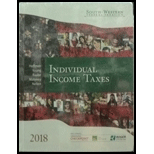
South-western Federal Taxation 2018: Individual Income Taxes
41st Edition
ISBN: 9781337385886
Author: William H. Hoffman, James C. Young, William A. Raabe, David M. Maloney, Annette Nellen
Publisher: Cengage Learning
expand_more
expand_more
format_list_bulleted
Question
Chapter 14, Problem 9DQ
a.
To determine
Give some suggestions to Person A regarding the tax consequences.
b.
To determine
Indicate whether Person W could achieve a better result by selling the assets in different tax years.
Expert Solution & Answer
Want to see the full answer?
Check out a sample textbook solution
Students have asked these similar questions
I need answer typing clear urjent no chatgpt used pls i will give 5 Upvotes.only typing .
Cash flow cycle
Abc
Chapter 14 Solutions
South-western Federal Taxation 2018: Individual Income Taxes
Ch. 14 - Prob. 1DQCh. 14 - Prob. 2DQCh. 14 - Prob. 3DQCh. 14 - Prob. 4DQCh. 14 - LO.1 Taylor is negotiating to buy some land. Under...Ch. 14 - Prob. 6DQCh. 14 - Prob. 7DQCh. 14 - Prob. 8DQCh. 14 - Prob. 9DQCh. 14 - Prob. 10DQ
Ch. 14 - Prob. 11DQCh. 14 - Prob. 12DQCh. 14 - Prob. 13DQCh. 14 - LO.4 Marilyn owns land that she acquired three...Ch. 14 - Prob. 15DQCh. 14 - Prob. 16CECh. 14 - Prob. 17CECh. 14 - Prob. 18CECh. 14 - Prob. 19CECh. 14 - Prob. 20CECh. 14 - Heather owns 400 shares of Diego Corporation...Ch. 14 - Prob. 22CECh. 14 - Prob. 23CECh. 14 - Prob. 24CECh. 14 - Prob. 25CECh. 14 - Prob. 26CECh. 14 - Prob. 27CECh. 14 - Prob. 28PCh. 14 - Prob. 29PCh. 14 - Prob. 30PCh. 14 - Prob. 31PCh. 14 - Prob. 32PCh. 14 - Prob. 33PCh. 14 - Prob. 35PCh. 14 - Yancys personal residence is condemned as part of...Ch. 14 - Prob. 41PCh. 14 - Nicky receives a car from Sam as a gift. Sam paid...Ch. 14 - Prob. 44PCh. 14 - Prob. 46PCh. 14 - Prob. 47PCh. 14 - Prob. 50PCh. 14 - Prob. 51PCh. 14 - Prob. 52PCh. 14 - On December 28, 2018, Kramer sells 150 shares of...Ch. 14 - Prob. 54PCh. 14 - Prob. 55PCh. 14 - Prob. 56PCh. 14 - Alton Newman, age 67, is married and files a joint...Ch. 14 - Prob. 58CPCh. 14 - Prob. 1RPCh. 14 - Prob. 2RPCh. 14 - Prob. 3RPCh. 14 - Prob. 1CPACh. 14 - Prob. 2CPACh. 14 - Prob. 3CPACh. 14 - Prob. 4CPACh. 14 - Prob. 5CPACh. 14 - Prob. 6CPA
Knowledge Booster
Learn more about
Need a deep-dive on the concept behind this application? Look no further. Learn more about this topic, accounting and related others by exploring similar questions and additional content below.Similar questions
- Overhead variance?arrow_forwardFind Cost account answerarrow_forwardHurwitz, LLC sells a parcel of waterfront land and a residential condo building with an adjusted tax basis of $100,000 and 50,000, respectively for $500,000. The original purchase price Hurwitz, LLC allocated to the building was $600,000. Hurwitz LLC has deducted $550,000 in depreciation expense. Hurwitz, LLC's realized gain on this transaction is $350,000. If Hurwitz LLC takes back a note as part of the proceeds, what is Hurwitz LLC's gross profit percentage? A. 83.33% B. 71.43% C. 70% D. 50% E. 30%arrow_forward
arrow_back_ios
SEE MORE QUESTIONS
arrow_forward_ios
Recommended textbooks for you
 Individual Income TaxesAccountingISBN:9780357109731Author:HoffmanPublisher:CENGAGE LEARNING - CONSIGNMENT
Individual Income TaxesAccountingISBN:9780357109731Author:HoffmanPublisher:CENGAGE LEARNING - CONSIGNMENT




Individual Income Taxes
Accounting
ISBN:9780357109731
Author:Hoffman
Publisher:CENGAGE LEARNING - CONSIGNMENT


How to (Legally) Never Pay Taxes Again; Author: Next Level Life;https://www.youtube.com/watch?v=q63F1pBrUHA;License: Standard Youtube License